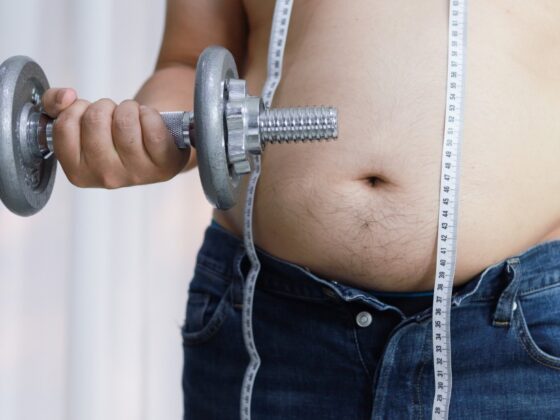Last Updated on 27th July 2023 by Charlie Walsh
Testosterone is a naturally occurring hormone produced primarily in men by the testicles and plays a vital role in sex drive, sperm production and muscle-mass.
However, production typically starts to decrease after the age of 30, with reports suggesting that 2 in every 100 men have low levels of testosterone (also known as Low-T).
So, What Symptoms Point to Low Testosterone (Low-T)?
Some of the signs that your body needs help producing testosterone seem unrelated at first glance. However, when you remember that your body functions are interrelated, it can help you understand what’s happening. That way, you can get the right treatment.
Here are 8 signs that you may have Low-T
1. Problems with erections
Low-T can make it more difficult to get or keep an erection. That’s because testosterone plays a role in stimulation by producing nitric oxide, a key factor in maintaining an erection.
Several factors influence erectile dysfunction besides Low-T, including smoking, high cholesterol, stress, diabetes, alcohol consumption and high blood pressure. Therefore, to determine if Low-T is contributing to erectile dysfunction, it’s important to see your doctor for a professional diagnosis.
2. Hair loss
Although hair loss increases in men and women due to aging, Low-T can contribute to premature hair loss in younger men.
3. Smaller testicles
If you notice that your testicles have gotten smaller, it may point to Low-T. If so, the scrotum will probably feel softer as well.
4. Reduced semen
Male ejaculation is made up mostly of semen, the fluid that helps sperm move towards unfertilized eggs during conception. Testosterone stimulates semen production. So, lower levels of semen may indicate that you have Low-T.
5. Reduced bone mass
With insufficient testosterone levels, your body may struggle to produce enough bone tissue, causing you to lose bone mass. In turn, low bone mass may leave you vulnerable to fractures and breaks.
6. Difficulty sleeping
Do you have difficulty falling asleep? Many men with Low-T have sleep apnea, which disrupts sleep and can become life-threatening.
7. Low sex drive
If you just don’t get into the mood as often as you used to, it may indicate Low-T. However, many things impact a diminished sex drive, such as age, anxiety, and difficulty in your relationship.
8. Reduced muscle mass
Testosterone impacts muscle mass. Therefore, low levels can significantly reduce your ability to build muscles.
Hot flashes, mood swings and increased body fat may indicate that testosterone and other hormones are off-kilter. So, if you experience reduced energy levels and any of the symptoms above, it may be time to look into possible causes and make an appointment with your doctor for a definitive diagnosis.
What Causes Low Testosterone?
There are many potential causes of Low-T, and the following list is far from comprehensive, however here are some of the most common causes.
- An injury or infection in the testes
- High levels of iron in the blood
- Pituitary gland tumors
- Hormones and other medications used to treat prostate cancer
- Steroids
- Alcohol and drug abuse
- Renal failure or liver cirrhosis
- AIDS
- Inflammatory conditions
- Kallman or Klinefelter syndromes (genetic disorders)
- Milk-producing prolactin hormone
- Obesity
- Diabetes
- Aging
- Sleep Apnea
- Delayed puberty
- Head trauma
- Radiation exposure
Testosterone Testing
A 2017 study in the United States set the benchmark typically used to define normal testosterone levels — between 264 – 916 ng/dL (nanograms per deciliter). As you can see, this is a wide range, and medical professionals look at the level of several other hormones that may indicate lower or higher levels of testosterone.
Your doctor may also check your blood prolactin and haemoglobin levels. Luteinizing hormone produced by the pituitary gland can also indicate whether you have normal, high or low levels of testosterone since it influences testosterone production in the body.
There are several tests and surveys that your doctor may use to diagnose whether your symptoms come from a lack of testosterone. Therefore, it’s important to have a frank discussion with your medical professional so that you can get the information to determine whether you need low testosterone treatment.
Treatment for Low Testosterone
What is the treatment for Low-T? Typically, medical professionals recommend testosterone replacement therapy or TRT. However, doctors will only prescribe TRT for patients with Low-T symptoms and conclusive blood test results.
You have a choice of several delivery methods for TRT, including the following:
- Gels
- Injections
- Skin patches
- Tablets
- Implanted pellets that slowly release testosterone
You might feel more like yourself within as little as four weeks.
Lifestyle Changes
If you are not ready for TRT, ask your doctor for recommendations to improve your testosterone levels naturally. Their recommendations will fit your specific condition and lifestyle. However, they might suggest a nutrient-rich diet as well as weight loss and exercise that may improve your natural testosterone production.
Some foods that contribute to a healthier environment for testosterone production include beef, eggs, tuna, fortified cereals and oysters. You can also try eating more beans and drinking milk enriched with vitamin D.
If lifestyle changes fail to significantly increase your testosterone levels, you can always talk to your doctor about hormone therapy.
Now that you know the symptoms and causes of Low-T, it may be time to have a conversation with your medical professional. With the right guidance, many men can boost their low-T levels and reinvigorate their sexuality.










